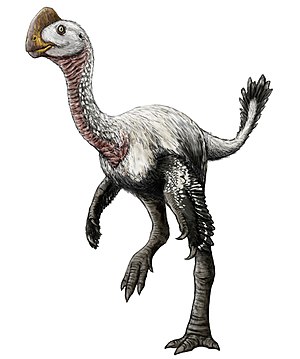Elmisaurus
| Elmisaurus | ||||||||||||
|---|---|---|---|---|---|---|---|---|---|---|---|---|

Live reconstruction of Elmisaurus |
||||||||||||
| Temporal occurrence | ||||||||||||
| Upper Cretaceous (late Campanium to early Maastrichtian ) | ||||||||||||
| 76.4 to 69.9 million years | ||||||||||||
| Locations | ||||||||||||
| Systematics | ||||||||||||
|
||||||||||||
| Scientific name | ||||||||||||
| Elmisaurus | ||||||||||||
| Osmólska , 1981 | ||||||||||||
| Art | ||||||||||||
|
||||||||||||
Elmisaurus was a theropod dinosaur from the group of Oviraptorosauria , which lived in the Upper Cretaceous of Asia and possibly North America.
The classification of this little-known genus within the Oviraptorosauria is controversial. While some researchers count Elmisaurus among the Caenagnathids , others assign him to a family of their own , the Elmisauridae.
From elmisaurus two types have been described: elmisaurus rarus from Mongolia and elmisaurus elegans from Alberta and Montana , where elmisaurus elegans often synonymous with chirostenotes is considered.
Research history
The type species Elmisaurus rarus was discovered in 1970 and first described by Halszka Osmólska in 1981 . The species is based on hand and foot bones found in Ömnö-Gobi-Aimag , an aimag of Mongolia . Stratigraphically , the fossils come from about 70 million year old sediments (early Maastrichtian ) of the Nemegt formation . The name Elmisaurus is derived from the Mongolian oil myi ("foot") and the ancient Greek sauros ("lizard"), which is supposed to indicate the ossification of the metatarsal bones, an autapomorphy (distinguishing feature ) of Elmisaurus .
In 1989, Currie described fossils from the Dinosaur Park Formation from Alberta ( Canada ) as another species, Elmisaurus elegans . The type material of this species was originally described by Parks (1933) as a new species of ornithomimus - Ornithomimus elegans - although Sternberg discovered a year later that it was not an ornithomimid . Currie and Russel (1988) later consider the elegans species to be identical to Chirostenotes pergracilis , although these researchers note that it was more delicate and could perhaps be listed as a Chirostenotes species of its own - as Chirostenotes elegans . In 1989 Currie described two new finds, where he attributed the elegans species to the genus Elmisaurus . Some later studies, including Osmólska et al. (2004), however, reject this assignment and continue to regard the elegans species as a species of chirostenotes .
Currie and Russell (1988) suspect that Caenagnathus sternbergi is identical to Elmisaurus (or Chirostenotes ) elegans . The type species of Caenagnathus , Caenagnathus collinsi , are considered by these researchers to be identical with Chirostenotes pergracilis . This assignment is shared by many later authors, for example Osmólska et al. (2004), whereby Caenagnathus is mostly considered invalid.
In the recent past, some foot bones found in the Hell Creek Formation of Montana have been attributed to Elmisaurus elegans (Varricchio, 2001; Buckley, 2002). The metatarsals described by Buckley are unusually large - three times the size of the finds described by Varricchio.
swell
literature
- Halszka Osmólska , Philip J. Currie , Rinchen Barsbold : Oviraptorosauria. In: David B. Weishampel , Peter Dodson , Halszka Osmólska (eds.): The Dinosauria . 2nd edition. University of California Press, Berkeley CA et al. 2004, ISBN 0-520-24209-2 , pp. 165-183.
Web links
- Michael Mortimer: Oviraptorosauria. In: The Theropod Database. Archived from the original on July 8, 2009 ; Retrieved April 29, 2009 .
Individual evidence
- ^ Gregory S. Paul : The Princeton Field Guide To Dinosaurs. Princeton University Press, Princeton NJ et al. 2010, ISBN 978-0-691-13720-9 , p. 152, online .
- ↑ Osmólska et al .: Oviraptorosauria. 2004, p. 167.
- ↑ Ben Creisler: Dinosauria Translation and Pronunciation Guide. ( Memento from October 13, 2011 in the Internet Archive )
- ↑ Osmólska et al .: Oviraptorosauria. 2004, p. 182.
- ↑ Osmólska et al .: Oviraptorosauria. 2004, p. 166.
- ↑ Elmisaurus elegans. In: DinoData. Retrieved May 1, 2020 .